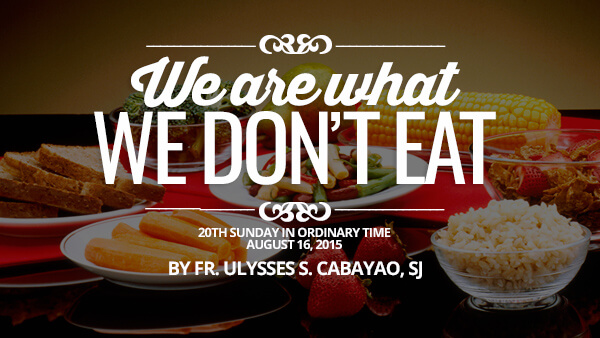


Fr. Ulysses S. Cabayao, SJ
20th Sunday in Ordinary Time
August 16, 2015
I propose that we dwell on two instances in today’s Gospel.
First, consider the crowd’s response. It is said that they “started arguing with one another.” But this was not a parliamentary debate. St. John uses the word, Ἐμάχοντο (emachonto), to illustrate what was really happening—they ‘fought’ among themselves. Something had stirred up this crowd into a frenzied chorus: “How can this man give us his flesh to eat?”
Sifting through this incensed throng, we pick out several distinct voices. You have the scandalized voices who are disgusted at Jesus’ claim that “the bread that I shall give is my flesh.” You have the gullible voices who are all agog as to how Jesus is just going to do that. You have the incredulous voices who find this kind of talk absurd. You have the smug voices who understand the semantic drift and are astounded at how idiotic everyone else is. You have the confused voices who can’t quite place this man whose words have made some impossible things happen. You have the bystanders who couldn’t care less about what Jesus said, but are reveling in the ruckus it has incited.
We can take pause here and imagine how our own voice would sound as we take our place in that mad ensemble. Had we been in that particular cultural and historical context, it would have been impossible not to get involved. How then would we have reacted?
Given our current times, however, we ought to also consider those who would rather not throw themselves into the fray. For some, religion is a messy affair, and there are more pressing concerns than fighting over some theological mumbo-jumbo. Would this “bread of life” discourse even raise an eyebrow? The cannibalistic and vampiric overtones of “my flesh is real food and my blood is real drink” might draw an occasional crowd, but they will be fickle, especially in this era of Game of Thrones, The Walking Dead, and The Vampire Diaries. At the very least, we can ask: what else would it take for Jesus’ pronouncements to stoke a real hunger and thirst for what He has to offer?
Second, consider how Jesus urges the Jewish crowd to eat his flesh and drink his blood.
It is said that we are what we eat. But we are also what we don’t eat. Food taboos define identities and establish social boundaries. Aside from prescribing what is permitted, different societies impose restrictions on food and eating. We are moulded as much by what, when, where and how we shouldn’t be eating. Cultures are recognizable by what is not found in their diet or by what food they find inedible or disgusting.
One of the distinguishing marks of being Jewish is kashrut, a set of laws that govern what kind of food is “fit” and how food is to be properly prepared. Kosher is food that has met the standards of kashrut. Someone who observes kosher cannot but be reminded of his own identity as a Jew every time that he eats or refuses to eat.
Jesus did not offend his Jewish listeners by being deliberately gross. He seems to have outraged them by venturing into what Jews considered to be non-kosher. While the Torah does not explicitly forbid eating human flesh and drinking human blood, it is treated as an issur asseh, “a prohibition that is not stated in the Torah in the form of a negative commandment, but is inferred from a positive commandment.” (Navon 2008) Since humans were not included in that list of land creatures that Jews may eat (Lev 11:2) and that “any blood whatever” (Lev 7:26) was certainly not to be eaten, it was thus presumed that consuming human flesh and blood were non-kosher.
Jesus’ exhortation challenges kashrut, which was a distinctive expression of Jewish identity. This identity is rooted in the Levitical injunction: “be holy for I am holy.” (Lev 11:44) Being kedoshim, ‘holy’, is fundamental to the Jewish ethos, and that implies being ‘set apart’. Jesus deftly confronts their notion of holiness by poking at this preoccupation with kashrut. In effect, he is hinting: Is keeping kosher the only thing that sets you apart? Is this what makes you holy? Where holiness once meant being set apart from everyone else, Jesus crosses the realm of taboos to expose the sociocultural and religious barriers that promote exclusivity rather than community, and entitlement rather than engagement.
The anthropologist Mary Douglas identifies another aspect of the Levitical understanding of holiness: “to be holy is to be whole, to be one.” (Douglas 1966) The linguistic fragmentation of the Son of Man into his flesh and blood broadens holiness to include infinite divisibility, in addition to unity. Where holiness once meant wholeness and completeness, Jesus offers Godself to be broken and shared by all. The further surprise is in how the indivisible God can be broken down into flesh to be gnawed, and blood to be imbibed. Where our usual image of the Divine overwhelms us with its incredible magnitude, the “bread from heaven” has actually chosen to feed us with bite-sized morsels that are continually being replenished by God’s prodigal generosity.
What I am suggesting right now is that we begin to examine the ways that we have persisted in our fossilized self-image, our unassailable impressions of other people, and our static adherence to ideas and beliefs. God deals in the currency of brokenness and fluidity. Food and Drink. Bread and Wine. Flesh and blood.
References:
Douglas, M 1966, Purity and Danger: An Analysis of Concepts of Pollution and Taboo, Routledge and Kegan Paul, London.
Navon, C 2008, Genesis and Jewish Thought, trans. D Strauss, Ringold Inc, Portland.